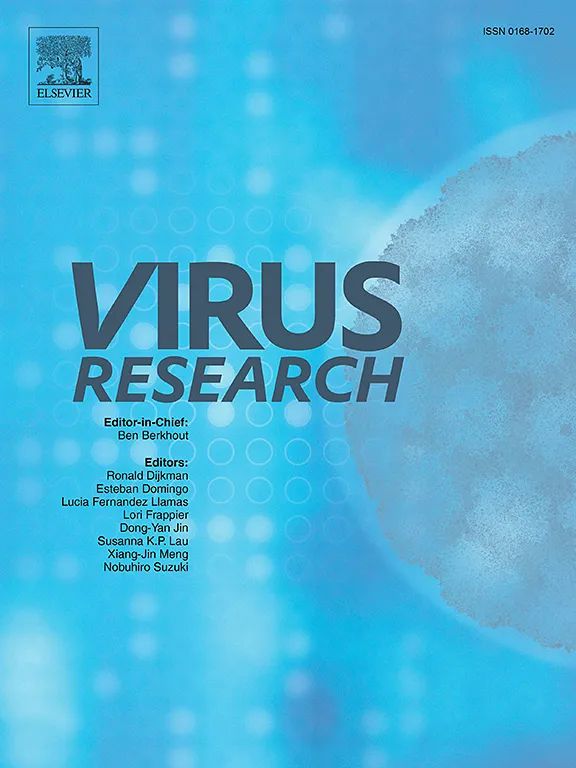巴基斯坦登革热病毒血清型-2 的优势(2023-2024 年):包膜基因的分子特征和抗病毒目标的探索。
IF 2.7
4区 医学
Q3 VIROLOGY
引用次数: 0
摘要
登革热病毒感染由 Flaviviridae 科的单股正链 RNA 病毒引起,是热带和亚热带地区面临的一项重大公共卫生挑战。这种病毒有四种血清型(DENV-1、2、3 和 4),主要由伊蚊传播。尽管进行了广泛的研究,但由于病毒的多样性和抗体依赖性增强(ADE)等复杂机制,有效的抗病毒治疗和疫苗仍然难以实现。本研究对巴基斯坦登革热病例(2023-2024 年)的 NS1 阳性血清样本进行了分析,以确定主要血清型和包膜(E)基因的特征,从而进一步探索抗病毒靶点。在 100 份样本中,63 份(63%)的 DENV-2 检测结果呈阳性,表明在此期间它占主导地位,而两份样本则显示出 DENV-2 和 DENV-3 的混合感染。利用嵌套 PCR 成功扩增了包膜基因,并通过凝胶电泳和桑格测序进行了验证。系统进化分析表明,DENV-2分离株与来自中国和印度的菌株高度相似。包膜蛋白结构的计算建模确定了潜在的抗病毒结合位点,进一步的分子对接研究表明,阿比多尔和槲皮素等特定的抗病毒化合物可以抑制病毒感染的早期步骤。此外,BepiPred-3.0 预测了几个 B 细胞表位,这些表位可用于疫苗开发。这些发现加深了我们对巴基斯坦登革热流行病学的了解,有助于开发有针对性的抗病毒疗法,为未来的疫苗接种策略和疫情管理提供了潜在的信息。本文章由计算机程序翻译,如有差异,请以英文原文为准。
Dominance of dengue virus serotype-2 in Pakistan (2023–2024): Molecular characterization of the envelope gene and exploration of antiviral targets
Dengue virus infection, caused by a single positive-stranded RNA virus from the Flaviviridae family, represents a significant public health challenge in tropical and subtropical regions. This virus has four serotypes (DENV-1, 2, 3, and 4), primarily transmitted by Aedes mosquitoes. Despite extensive research, effective antiviral treatments and vaccines remain elusive due to the viral diversity and the complex mechanisms such as antibody-dependent enhancement (ADE). In the current study, NS1-positive serum samples from dengue cases in Pakistan (2023–2024), were analyzed to determine the predominant serotype and characterize the envelope (E) gene for further exploration of antiviral targets. Out of 100 samples, 63 (63%) tested positive for DENV-2, indicating its predominance during this period, while two samples showed mixed infections with DENV-2 and DENV-3. The envelope gene was successfully amplified using nested PCR, validated through gel electrophoresis and sanger sequencing. Phylogenetic analysis revealed high similarity of the DENV-2 isolates to strains from China and India. Computational modeling of the envelope protein structure identified potential antiviral binding sites and further molecular docking studies suggested that specific antiviral compounds like Arbidol and Quercetin can inhibit early steps in viral infection. Additionally, BepiPred-3.0 predicted several B-cell epitopes, which could be useful for vaccine development. These findings enhance our understanding of dengue epidemiology in Pakistan and contribute to the development of targeted antiviral therapies, potentially informing future vaccination strategies and outbreak management.
求助全文
通过发布文献求助,成功后即可免费获取论文全文。
去求助
来源期刊

Virus research
医学-病毒学
CiteScore
9.50
自引率
2.00%
发文量
239
审稿时长
43 days
期刊介绍:
Virus Research provides a means of fast publication for original papers on fundamental research in virology. Contributions on new developments concerning virus structure, replication, pathogenesis and evolution are encouraged. These include reports describing virus morphology, the function and antigenic analysis of virus structural components, virus genome structure and expression, analysis on virus replication processes, virus evolution in connection with antiviral interventions, effects of viruses on their host cells, particularly on the immune system, and the pathogenesis of virus infections, including oncogene activation and transduction.
 求助内容:
求助内容: 应助结果提醒方式:
应助结果提醒方式:


